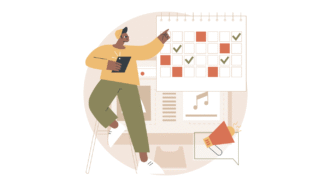LESSON OVERVIEW
In this lesson students practise the use of quantifiers with countable and uncountable nouns (too much, too many, (not) enough) while talking about typical problems faced by most cities.
QUANTIFIERS WITH COUNTABLE AND UNCOUNTABLE NOUNS
In the first activity, students look at five photos showing different aspects of a city life and describe them using the words given in a box (e.g. pollution, rubbish, traffic). After a short discussion about their own cities and what they like and dislike about them, students classify the nouns from the first exercise into countable and uncountable. Then, they look at some pictures of sample campaign slogans (e.g. Clean air for everyone!) and match them to the city problems . The aim of this exercise is to expose students to sentences containing quantifiers (too much, too many, (not) enough) so they are able to understand how to use them and complete five rules in the next task.
CONTROLLED & FREE PRACTICE
The second part of the lesson starts with a gap-fill task. Students choose a word from a box (e.g. too, much) and complete seven gapped sentences. Then, they move on to another set of sentences and have to find and correct the mistakes in each of them. After having practised the quantifiers with countable and uncountable nouns in a controlled way, they are ready to practise them orally. They talk about problems faced by six famous cities in the world using too/too many/too much and (not) enough. The lesson finishes with another discussion about students’ cities and their problems, but this time students focus on possible solutions local people, as well as governments, could come up with to improve people’s lives there.
WORKSHEETS
Subscribe to unlock these and many other Standalone lesson with the Premium plan
Subscribe














Hi! You have no ideia how happy this has made me! I’ve been typing “quantifiers” on the search box day in, day out! I have a question though….isn’t noise both countable and uncountable?
Hi Bianca! Thanks for taking the time to comment! Good to hear that the lesson plan is useful 🙂
Sure, you’re right, we’ve just added ‘noise’ to both columns.
These are what I call handy tools. Hands down for the service provided.
Thank you!
I appreciate you sharing this wonderful lesson plan with us. I look forward to using it.
Thanks! I hope you have a good class with it 🙂
Great lesson. However, I have a few suggestions – for truly beginning students, and some others that do not make this connection, a good idea would be to add some revision for there is/are plus C/U nouns, as it is practised in the lesson, plus perhaps some element to help them notice the different pattern with enough (adj+enough, enough+noun). Other than that I really enjoy using it.
I’m happy you enjoy the worksheet and thanks for sharing your ideas with the ESL Brains community 🙂
I have used this lesson several times and my students loved it. Thank you so much .
Great to hear that! Thanks for the comment!
Thank you for the lesson — I really liked that you included both British and American expressions. I just wondered why only parking was used, rather than car park (British English) or parking lot (American English)? thanks again !
Happy you like the lesson 🙂 Regarding ‘parking’, we used it as it’s an uncountable noun, so we needed it for the grammar part in the lesson. However, it’s a nice idea to tell students about the other two expressions 🙂